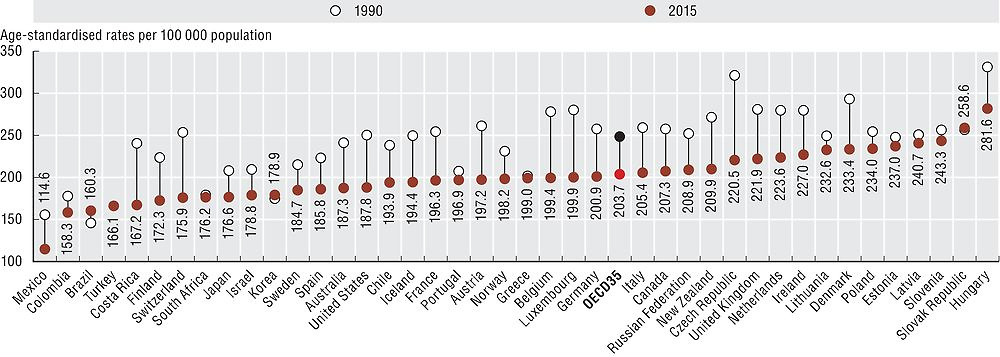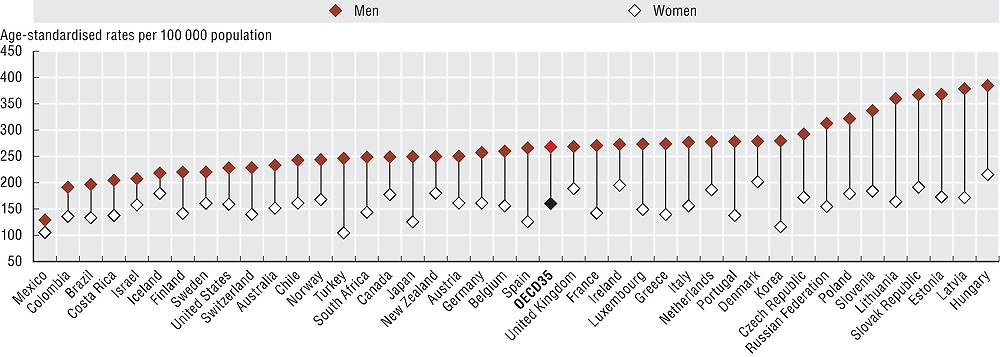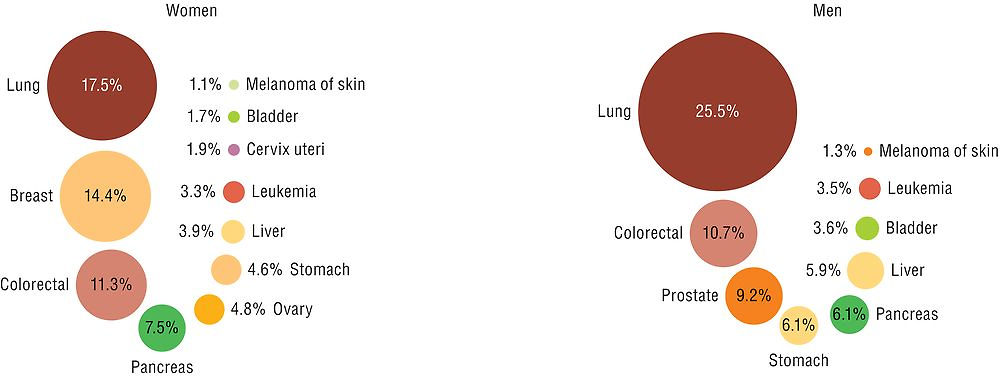Mortality from cancer
Cancer is the second leading cause of mortality in OECD countries after circulatory diseases, accounting for 25% of all deaths in 2015, up from 15% in 1960. In a number of countries such as Denmark, France, Japan, the Netherlands, Canada, the United Kingdom, Spain, Belgium and Australia, the mortality rate for cancer is higher than for circulatory diseases. The rising share of deaths due to cancer reflects the fact that mortality rates from other causes, particularly circulatory diseases, has been declining more rapidly than for cancer.
There are more than 100 different types of cancers. For a large number of cancer types, the risk of developing the disease rises with age. While genetics is a risk factor, only about 5% to 10% of all cancers are inherited. Modifiable risk factors such as smoking, obesity, lack of exercise and excess sun exposure, as well as environmental exposures, explain up to 90-95% of all cancer cases (Anand et al., 2008). Prevention, early detection and treatment remain at the forefront in the battle to reduce the burden of cancer (OECD, 2013).
In 2015, the average rate of mortality attributable to cancer across OECD countries was just over 200 per 100 000 population (Figure 3.10). Mortality due to cancer was lowest in Mexico, Turkey, Finland, Switzerland, Japan, Israel and Korea, with rates less than 180 per 100 000 population. Among partner countries, rates were also less than 180 per 100 000 in Colombia, Brazil, Costa Rica and South Africa. Hungary, the Slovak Republic, Slovenia and Latvia bear the highest cancer mortality burden, with rates in excess of 240 per 100 000 population.

Source: OECD Health Statistics 2017.
In most OECD countries, cancer-related mortality rates have fallen since 1990, with the largest reductions in the Czech Republic and Switzerland. On average, rates fell by 18% between 1990 and 2015. Substantial declines in mortality from stomach cancer, colorectal cancer, lung cancer for men, breast, cervical and ovarian cancer for women, as well as prostate cancer for men contributed to this reduction. However, these gains were partially offset by increases in the number of deaths due to cancer of the liver, skin and pancreas for both sexes, as well as lung cancer for women.
Mortality due to cancer is consistently higher for men than for women in all countries (Figure 3.11). The gender gap was particularly wide in Korea, Turkey, Latvia, Estonia, Spain and Portugal, with rates among men more than twice those for women. This gender gap can be explained partly by the greater prevalence of risk factors among men, notably smoking.

Source: OECD Health Statistics 2017.
Among men, lung cancer imposes the highest mortality burden, accounting for 22% of all cancer-related deaths (Figure 3.12). For women, lung cancer accounted for 16% of all cancer-related deaths. In many countries, lung cancer mortality rates for men have decreased over the last 25 years, in particular in Mexico, the Netherlands, Czech Republic, Finland and the United Kingdom where they fell by about 50%. But lung cancer mortality has risen for women in several countries such as the Netherlands, France and Spain where it has more than doubled since 1990. These conflicting trends are, to a large degree, explained by the high number of females who started smoking several decades later than males.

Note: Shares of the sum of cancer-related deaths across OECD countries, by gender.
Source: OECD Health Statistics 2017.
Breast cancer is the second most common cause of cancer mortality in women in many OECD countries. While there has been an increase in the incidence of breast cancer over the past decade, mortality has declined in most countries due to earlier diagnosis and better treatment. Mortality from breast cancer increased in Korea and Japan, though the rates there remained the lowest in 2015. Mortality rates from breast cancer in 2015 were highest in Ireland, Iceland, Hungary, Denmark and the Netherlands.
Colorectal cancer is a major cause of cancer mortality among both men and women (second-highest cause of cancer mortality in men and third in women). In Japan, it is the leading cause of cancer mortality in women. In 2015, colorectal cancer mortality was lowest in Mexico and Turkey, and highest in Hungary and the Slovak Republic. Prostate cancer has become the most common cancer among men in many OECD countries, particularly among men aged 65 years and over.
Mortality rates are based on numbers of deaths registered in a country in a year divided by the size of the corresponding population. The rates have been directly age-standardised to the 2010 OECD population (available at http://oe.cd/mortality) to remove variations arising from differences in age structures across countries and over time. The source is the WHO Mortality Database.
Deaths from all cancers are classified to ICD-10 codes C00-C97. The international comparability of cancer mortality data can be affected by differences in medical training and practices as well as in death certification across countries.
References
Anand, P. et al. (2008), “Cancer Is a Preventable Disease that Requires Major Lifestyle Changes”, Pharmaceutical Research, Vol. 25, No. 9, pp. 2097-2116.
OECD (2013), Cancer Care: Assuring Quality to Improve Survival, OECD Publishing, Paris, https://doi.org/10.1787/9789264181052-en.
Slawomirski, L., A. Auraaen and N. Klazinga (2017), “The Economics of Patient Safety: Strengthening a Value-based Approach to Reducing Patient Harm at National Level”, OECD Health Working Papers, No. 96, OECD Publishing, Paris, https://doi.org/10.1787/5a9858cd-en.
